Series Introduction
 Traditional holidays offer a treasure trove of opportunity for the Gospel, if you know how to use them. I use four, in particular, to explain the Gospel to my kids. Two are obvious, the other two require some creativity (more on this later). I use these four holidays over the course of a year to explain four basic aspects of the Gospel.
Traditional holidays offer a treasure trove of opportunity for the Gospel, if you know how to use them. I use four, in particular, to explain the Gospel to my kids. Two are obvious, the other two require some creativity (more on this later). I use these four holidays over the course of a year to explain four basic aspects of the Gospel.
- The Fall and the Promise of Christ
- The Arrival of Christ
- The Cross of Christ
- The Return of Christ
These elements comprise what I sometimes call the full Gospel. Some presentations leave out the Fall, which set the stage for the Gospel. Others leave out the return of Christ which is the culmination of the Gospel. This is a mistake, in my opinion. Both of these events, historical and future, give vital context to the Gospel message. (I discussed this in a recent article: Should Churches Avoid Genesis and Revelation.)
In this four-part series, I’ll offer some simple ideas on how to use these four holidays, and their symbols, to their full theological potential. Used correctly, they are excellent conveyers of the Gospel message.
Holiday Symbols
The key in utilizing any holiday to its full potential is establishing meanings for its various symbols. All holidays have traditional unique colors and symbols we are familiar with. In many cases, they have wonderful traditional meanings that can be learned and shared (as in the case of Christmas). In other cases, the symbols are good, but vague, and require explaining (as in the case of Easter). Still, in other cases, they need to be creatively repurposed and put to good use. That will be the case for the first holiday featured in this article.
Holiday Liberty
Before I begin, however, I should say a word about Christian liberty. Some Christians avoid holidays for a range of reasons. They assert traditional Christian holidays are not found in the Bible, and that we are not commanded to celebrate Christ’s birth or resurrection on specific days. This is true. Others argue Christmas, Easter, and other favorites are pagan in origin. This is not true, as I’ll explain. The arguments above are sincere, but critically flawed in a number of ways.
First, God has given us liberty in regard to holiday observances. Paul said we are free to set apart sacred days.
Rom. 14:5 One person considers one day more sacred than another; another considers every day alike. Each of them should be fully convinced in their own mind. 6 Whoever regards one day as special does so to the Lord….
Holiday observances are a matter of conscience. There’s no prohibition against a particular day set apart unto the Lord. It doesn’t matter if a holiday is not mentioned in Scripture. If it’s celebrated unto the Lord, it’s approved.
Second, historical uses of certain dates and symbols are totally irrelevant. God is not concerned about what pagans did yesterday, he is concerned about what you do today. If you glorify God on a particular day with a clear conscience, you need not worry about what ancient pagans did. It doesn’t matter if they used the same symbol you’re using for a different purpose. If you use it for good, God approves.
Third, most of these claims regarding pagan origins are bogus. They are often based on poor research, unreliable sources and poor logic. I know, because I’m guilty of it. I used to believe Halloween was a revived Samhain festival, Christmas was a Saturnalia celebration, and Easter was the name of an ancient Saxon goddess. Boy was I duped! I’ll discuss these in more detail as they come up. Let’s go ahead and tackle the first holiday of our series.
The Fall and the Promise of Christ
When I explain the Gospel, I generally start with the Creation and the Fall in the Garden of Eden. Some may find this strange, but I would argue it’s essential. Why start anywhere else but the beginning? Before I explain Jesus’ arrival and sacrifice, I need to explain why God sent him. How can I explain the life we have in Christ without first explaining the death we suffered in Adam? Death is not a pleasant subject, but it is a vital one. I need to explain this enemy (1Cor. 15:26) that entered the world and prompted the coming of Christ.
Halloween
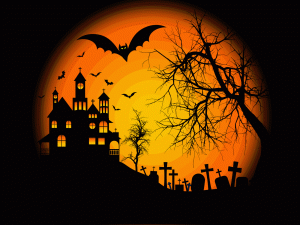 As you may have guessed, I believe the best time to do this is during Halloween season, when symbols of death are everywhere—when gravestones, skeletons and deadly creatures dominate the landscape.
As you may have guessed, I believe the best time to do this is during Halloween season, when symbols of death are everywhere—when gravestones, skeletons and deadly creatures dominate the landscape.
I understand the uneasiness. Like many, I’ve stumbled over Halloween. I had no idea what to do with it, and, for many years, ignored it. Then it hit me. Why not use it to explain the Fall and Curse? Why not use it to explain the origins of death which Christ came to conquer?
It just so happens Halloween highlights something important to the Gospel, and obscured by modern evolutionary culture. It is, therefore, the first holiday of my year-long Gospel presentation.
- The Fall and the Promise of Christ – Halloween
- The Arrival of Christ
- The Cross of Christ
- The Return of Christ
Confusion About Death
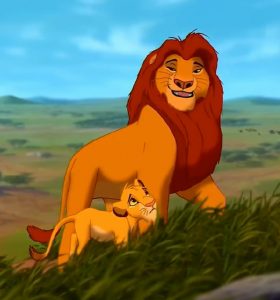 Our culture, today, has a flawed view of death in that they don’t know where it came from, or why it exists. Most believe it’s been in place millions of years in accordance with evolutionary timelines, and most, interestingly, don’t see it as a bad thing. A popular kid’s movie has rebranded it the circle of life.
Our culture, today, has a flawed view of death in that they don’t know where it came from, or why it exists. Most believe it’s been in place millions of years in accordance with evolutionary timelines, and most, interestingly, don’t see it as a bad thing. A popular kid’s movie has rebranded it the circle of life.
When we die, our bodies become the grass, and the antelope eat the grass. And so, we are all connected in the great Circle of Life…
A great circle? That doesn’t sound so bad!
Evolutionary Confusion
The reason for this confusion is simple. People are confused about the history of the earth.
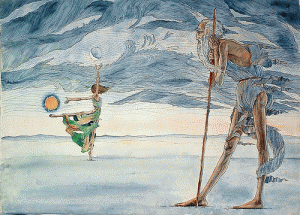 There are two basic false gods of our age—Mother Nature and Father Time. These are not personal gods like the pagans worshipped, but rather “scientific” concepts. All you need are small changes in nature, eons of time, and voilà! Nothing is impossible. Even something as complex as the human brain can slowly self assemble over enough time. No Creator necessary.
There are two basic false gods of our age—Mother Nature and Father Time. These are not personal gods like the pagans worshipped, but rather “scientific” concepts. All you need are small changes in nature, eons of time, and voilà! Nothing is impossible. Even something as complex as the human brain can slowly self assemble over enough time. No Creator necessary.
These ideas (gods) have even infiltrated the modern Church—especially the idea deep time (millions of years). As a result, the Creation account has been obscured, and the origin of death has become a mystery. Think about it. If evolutionary timelines are correct, death and suffering existed long before the first humans appeared. Prehistoric animals like dinosaurs could not have died because of anything Adam did in the Garden of Eden. Death existed long before this and has nothing to do with Adam or his sin.
The Biblical View of Death
The biblical history of death, however, is very different. The Bible describes it as an enemy (1Cor. 15:26) that entered the world through Adam (Gen. 2:17, 3:19, Rom. 5:12-19). God did not initially create the cycle of death we see all around us. In the beginning, everything was “very good” (Gen. 1:31).
Gen. 1:31 God saw all that he had made, and it was very good. And there was evening, and there was morning—the sixth day.
Death came later when Adam disobeyed and was banished from the Garden of Eden. It entered the world through sin, and has reigned ever since.
The Halloween Opportunity
This is why I see such a wonderful opportunity in Halloween. What could possibly be a better time to set the record straight on the history of the earth, and the origins of death? Christmas and Easter, as wonderful as they are, need context. The good news of Christ’s arrival and sacrifice only make sense in light of the bad news of Adam’s Fall.
I also find it convenient that Halloween precedes Christmas and Easter, following the biblical chronology—Curse (Halloween), Christ’s arrival (Christmas), the Cross (Easter). Halloween, Christmas and Easter occur in succession, just as the historical events did, making for a perfect sequential presentation. Perhaps you’re seeing the same opportunity I’m seeing.
The Evasive History of Halloween
Before getting into its symbols and traditions, I should touch briefly on the origins of Halloween. For years I bought into the theory it was a refurbished Samhain (SAH-win) festival, in a feeble attempt christianize a pagan holiday. Many good, smart, godly people believe this. It’s not true. Samhain was a real historical cross-quarter festival of the ancient Celts, but far removed from the original All Saints Day and modern Halloween. I’ve searched in vain for a link between Samhain and Halloween with no success. Like many other links, it’s missing.
Halloween (also known as All Hallows Eve), began centuries ago as the eve of All Saints day—a Christian holiday which honors martyrs (men and women murdered for their faith). It was, in essence, a Christian memorial day. In this case, however, the Eve began to overshadowed the Day, and took on a very different emphasis. Unlike Christmas Eve, which upholds the emphasis of the Day it precedes, All Hallows Eve became a contrast. All Saints Day highlights saints who have died, while the Eve highlights the not-so-saintly, and highlights death in general. I’m not sure how and why this happened, but it’s easy to see the contrast, and the logical link between Halloween and All Saints Day (rather than some ancient pagan festival).
I also should point out, this contrast has been expressed differently throughout history, especially in America. Many don’t know this, but Halloween in America, not too long ago, bore no resemblance to our modern celebration. There was a time, in 1800s and early 1900s, “When Halloween Was All Tricks and No Treats.” It was, instead, a national day of pranks and mischief. Some of these pranks were so severe they ended in fatalities, both for the pranked and pranksters. The most dangerous instances involved arson (source: Halloween Was Once So Dangerous That Some Cities Considered Banning It).
Thankfully, things have changed. By the mid 1900s, youths on Halloween went from terrorizing communities, to wearing costumes and politely asking neighbors for candy. Here’s how:
The Founder of Modern Halloween?
There are some wild theories about the origins of Halloween parties and the Trick or Treat tradition. I used to believe it was the product of pagans collaborating with satanists. If you’ve had similar thoughts, I’m happy to tell you the real story. From the article, Elizabeth Krebs, the Founder of our Modern Halloween:
If you think Halloween has its origins with satanists and pagans, guess again. Elizabeth Krebs, a woman you’ve probably never heard of unless you are from Hiawatha, Kansas, is actually a very important part of our history with Halloween and how it’s currently celebrated.
Krebs, like everyone else at that time, was distressed about recurring property damage on October 31st. The All Hallows Eve pranksters were active in her community, and her prized garden was a favorite target. The article continues:
Elizabeth Krebs was the president of the local garden club in Hiawatha, Kansas back in 1912. On the morning of November 1st of that year, Elizabeth woke to find her prize-winning garden smashed to bits. There were other reports of havoc; fences being destroyed, houses egged, and windows being smashed. She knew it had to be the same culprits who had destroyed other flowers around town – rowdy children. In her town, kids were notorious for creating all kinds of destruction on Halloween night. Desperate to make her town garden-smashing free, Elizabeth put together a plan.
Her plan, in essence, was a party the following year (1913) on October 31st. All the kids in her neighborhood were invited to enjoy a variety of sweet treats, which dissuaded many from engaging in mischief that night. Not all, however. Some vandalism still occurred.
Sticking to her guns, she organized an evening costume parade the following year, in 1914. Success! Instead of acting like ghouls, the kids merely dressed up like them. No vandalism occurred and a new American tradition was born. The practice spread quickly throughout Kansas and the rest of the United States.
Halloween may be secular in origin, but it’s not pagan or satanic. Don’t be stumbled by these rumors.
Using Halloween Symbols
With that in mind, let’s delve into the potential usefulness of modern Halloween symbols. Unlike Christmas and Easter (which we’ll cover in the next articles), Halloween symbols don’t have much in the way of traditional biblical symbolism. Nevertheless, its traditional symbols can be useful in explaining the darkest time in human history—the Fall.
GRAVESTONES & SKELETONS
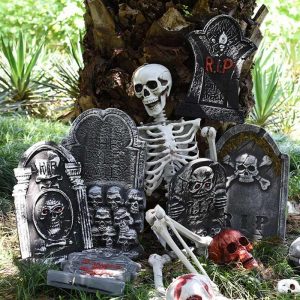 Gravestones and skeletons are the most basic symbols of Halloween. They are prominent and obvious. I don’t believe there’s a more definitive symbol out there.
Gravestones and skeletons are the most basic symbols of Halloween. They are prominent and obvious. I don’t believe there’s a more definitive symbol out there.
Gravestones and skeletons remind us of what entered the world when Adam sinned. “but of the tree of the knowledge of good and evil you shall not eat, for in the day that you eat of it you shall surely die.” (Gen. 2:17) “For dust you are, And to dust you shall return.” (Gen. 3:19) Only Bible believers have a true understanding of death. I suggest using these symbols to broach the subject and explain it to others, starting with our kids. If we don’t, who will?
Paul lamented,
Rom. 7:24 What a wretched man I am! Who will rescue me from this body that is subject to death? 25 Thanks be to God, who delivers me through Jesus Christ our Lord!
EVIL CREATURES
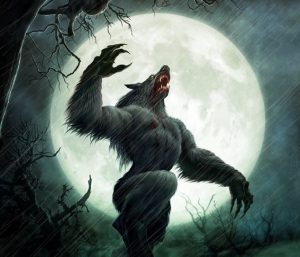 While the creatures of Halloween often have a supernatural element, they can remind us of how treacherous some humans and animals have become. Predation among animals began after the Fall, and will continue until Christ returns and restores all things (Is. 11:6-9).
While the creatures of Halloween often have a supernatural element, they can remind us of how treacherous some humans and animals have become. Predation among animals began after the Fall, and will continue until Christ returns and restores all things (Is. 11:6-9).
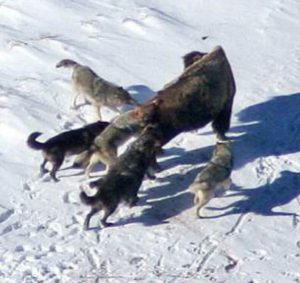 Werewolves are scary, but so are real wolves who take down their prey slowly and eat them while they are still alive. Let your kids know this is not a great circle, but a tragic cycle that entered the world through Adam. Let them also know it will cease, one day, when Christ returns.
Werewolves are scary, but so are real wolves who take down their prey slowly and eat them while they are still alive. Let your kids know this is not a great circle, but a tragic cycle that entered the world through Adam. Let them also know it will cease, one day, when Christ returns.
“The wolf also shall dwell with the lamb, The leopard shall lie down with the young goat, The calf and the young lion and the fatling together; And a little child shall lead them.
Other iconic symbols include vampires, witches, and monsters created in laboratories. While fictional, they can remind us of the non-fictional treachery of some actual human beings. Monsters are real, and take many forms. They may not look as fancy as the mythical ones, but they are just as wicked. Use the symbolism of evil creatures to broach the subject of the sin nature that is in all men—a nature that entered the world when Adam sinned—a nature we must fight every day. This fight won’t end until Jesus returns and subdues all enemies.
Fall Season
For many, the Fall Equinox marks the beginning of Halloween season (usually September 22). The Equinox, in and of itself, offers rich and useful theological symbolism. It marks that time of year when the nights become equal in length to the days, and then overtake them going forward. Most young kids don’t know that night and day lengths change throughout the year. Explain this phenomenon, and then explain how it coincides symbolically with what happened in the Garden of Eden. Just as the Fall Equinox marks the beginning of literal darkness, so Adam’s Fall marks the beginning of spiritual darkness.
 Fall season is also characterized by colder weather and dying leaves. This also can symbolically remind us of Adam’s fall, when death entered the world (Rom. 5:12-19).
Fall season is also characterized by colder weather and dying leaves. This also can symbolically remind us of Adam’s fall, when death entered the world (Rom. 5:12-19).
It’s easy to see why various day of the dead festivals are observed during the Fall. The symbolism is hard to miss.
Nocturnal Animals
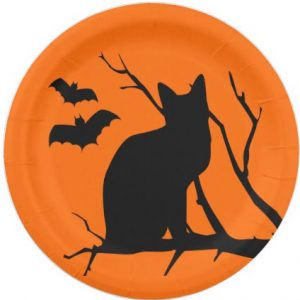 Bats, cats and rats are on full display during Halloween season. The association seems fairly obvious. Fall marks the time when nights surpass the days in length. It’s easy to see how creatures of the night would become highlighted.
Bats, cats and rats are on full display during Halloween season. The association seems fairly obvious. Fall marks the time when nights surpass the days in length. It’s easy to see how creatures of the night would become highlighted.
Let nocturnal animals like bats and cats symbolize the darkness they lurk in. Let this, in turn, symbolize the spiritual darkness Adam allowed into the world, when he disobeyed God. We have all been born into this spiritual darkness. Those of us in Christ, however, have been set free from it.
Eph. 5:8 For you were once darkness, but now you are light in the Lord. Live as children of light
Spiders and Webs
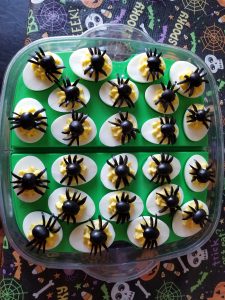 Spiders and their webs always play a significant role in Halloween decor. They are prominent on walls, ceilings and even on tasty food dishes. It makes sense, considering they are apex predators in the bug world. Spiders, like other predatory animals, remind us we are in a fallen world where death reigns. Death was defeated at the Cross, but will remain until Christ returns to restore the world.
Spiders and their webs always play a significant role in Halloween decor. They are prominent on walls, ceilings and even on tasty food dishes. It makes sense, considering they are apex predators in the bug world. Spiders, like other predatory animals, remind us we are in a fallen world where death reigns. Death was defeated at the Cross, but will remain until Christ returns to restore the world.
When you see spider decor, use it to bring up the topic of predation, and where it came from. Remind your kids that modern carnivorous animals didn’t always crave blood. They used to eat vegetables.
Gen. 1:30 Also, to every beast of the earth, to every bird of the air, and to everything that creeps on the earth, in which there is life, I have given every green herb for food”; and it was so.
For an interesting read, see: Pollen-eating spiders
Spooky Trees
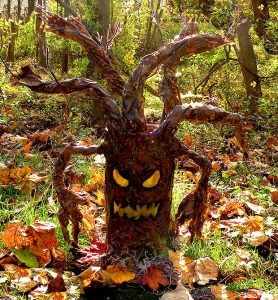 Spooky trees are another prominent symbol on Halloween. They are usually dark with daunting branches that can grab you at any moment. We all remember the tree from 80s Poltergeist film that attacked Robbie and nearly devoured him.
Spooky trees are another prominent symbol on Halloween. They are usually dark with daunting branches that can grab you at any moment. We all remember the tree from 80s Poltergeist film that attacked Robbie and nearly devoured him.
When I see these trees, I’m reminded of the Tree of Knowledge of Good and Evil. Adam was expressly warned not to partake—that he would die if he partook. He didn’t listen.
The death we see all around us, today, involved a tree at the very beginning of history. Remind your kids of this history when you come across these symbols. Remind them, also, of the Tree of Life that was in the Garden—a tree we will see again in heaven.
(Suggested reading: The Tree of the Knowledge of Good and Evil: Evil or Good?)
PUMPKINS
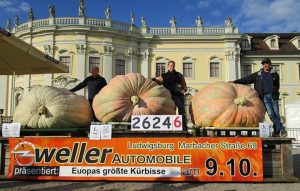 Pumpkins are a prominent feature of Halloween decor. They, by far, are my favorite fruit. Nothing rivals them in size or weight. Can you believe the heaviest one on record was over 2600 pounds? I surmise they were even bigger in the past, before the Flood.
Pumpkins are a prominent feature of Halloween decor. They, by far, are my favorite fruit. Nothing rivals them in size or weight. Can you believe the heaviest one on record was over 2600 pounds? I surmise they were even bigger in the past, before the Flood.
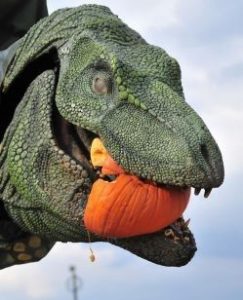 We allow pumpkins to remind us of God’s provision after the Fall. Their size and protective skin preserve their food for men and animals throughout the Fall season, and even into the Winter season.
We allow pumpkins to remind us of God’s provision after the Fall. Their size and protective skin preserve their food for men and animals throughout the Fall season, and even into the Winter season.
It’s also fun to speculate about what animals fed on these giants fruits throughout history. Did T-Rex bite into them? His teeth suggest he was carnivorous, but we know from Scripture that all animals were once vegetarian. Even T-Rex was an herbivore before the Fall. (for further reading, see: When did animals become carnivorous?, also Unexpectedly Vegetarian Animals—What Does it Mean?)
Jack-o’-lanterns
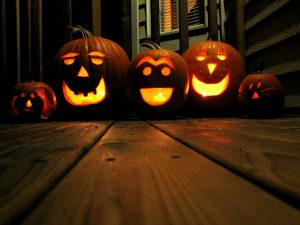 Finally, we come to the Jack-o’-lantern—the true face of Halloween. It is by far the most prominent symbol of the season. And unlike other Halloween symbols, this one can be used to teach a positive aspect of the Gospel.
Finally, we come to the Jack-o’-lantern—the true face of Halloween. It is by far the most prominent symbol of the season. And unlike other Halloween symbols, this one can be used to teach a positive aspect of the Gospel.
History of Jack-o’-lanterns
First, let’s get a little into its history. The backstory of this symbol is interesting. Originally, in Ireland, turnips were carved into lanterns based on the legend of Stingy Jack. Jack was a shrewd man who escaped Hell by tricking the devil, but also missed out on Heaven, due to his stinginess. Stuck between realms, he wanders in the darkness with a lantern carved from a turnip. You can read a more detailed account of the legend here: Jack O’Lanterns and The Tale Of Stingy Jack. When the tradition came to America, turnips were replaced with pumpkins, being more readily available and easier to hollow out.
The legend is interesting, but theologically flawed. Men cannot fool the devil, no matter how shrewd they think they are. To be fair, the story does, in a sense, teach this, in that Stingy Jack didn’t make it to heaven.
Hijack The Lantern
I see something a little different in the Jack O Lantern, however. I suppose I’ve hijacked it, and given it some new symbolism. Parting from traditional symbolism, we, instead, find significance in dim flickering light that shines forth from it. This reminds us of a specific prophecy that God gave to Adam, Eve and the Serpent.
Light is a significant metaphor in the Bible, representing revelation and knowledge. This includes prophecies that are often vague and dim at the time they are given. If the history of Jesus is represented by the bright lights on Christmas, it seems fitting that prophecies about Christ, before his first coming could be represented by dim lights.
The Promise of Christ
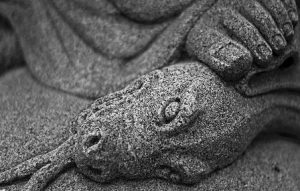 The protevangelium, or first Gospel, as it’s sometimes called, is a prophecy that God spoke to the Serpent, in the Garden of Eden.
The protevangelium, or first Gospel, as it’s sometimes called, is a prophecy that God spoke to the Serpent, in the Garden of Eden.
So the LORD God said to the serpent: “Because you have done this, You are cursed more than all cattle, And more than every beast of the field;……..And I will put enmity Between you and the woman, And between your seed and her Seed; He shall bruise your head, And you shall bruise His heel. (Gen. 3:14-15)
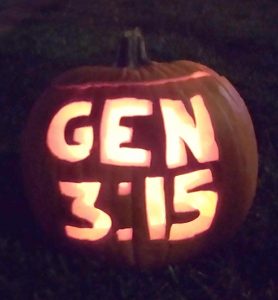 According to this promise, a male (he) offspring would one day be born of a woman (her seed). He would be hated (enmity) by the devil’s (Serpent’s) offspring. The prophecy states he would fatally wound the devil (bruise your head), while non-fatally wounding himself (bruise your heal).
According to this promise, a male (he) offspring would one day be born of a woman (her seed). He would be hated (enmity) by the devil’s (Serpent’s) offspring. The prophecy states he would fatally wound the devil (bruise your head), while non-fatally wounding himself (bruise your heal).
From that moment, Adam and his descendants began watching for the coming Seed, who would conquer the Serpent. Their knowledge of him was limited, like a dim light. It got brighter as more prophetic details were supplied, but didn’t become bright until Christ himself arrived (which we’ll discuss in the next article).
Make no mistake, however. God proclaimed Jesus to Adam and Eve even as He cursed the world. For further study see: Seed of Promise in Genesis 3:15, What is the protoevangelium? and What does Genesis 3:15 mean that “he will crush your head, and you will strike his heel”?.
Halloween Colors
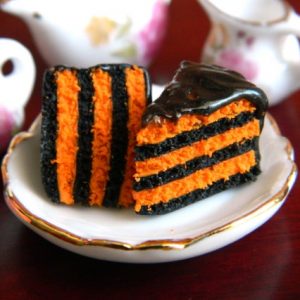 Like all holidays, Halloween has distinctive colors. Without question, orange and black dominate. Orange became prominent, likely in association with fire or perhaps the color of pumpkins. Black likely comes from the darkness that surrounds the season.
Like all holidays, Halloween has distinctive colors. Without question, orange and black dominate. Orange became prominent, likely in association with fire or perhaps the color of pumpkins. Black likely comes from the darkness that surrounds the season.
For us, black represents the darkness brought on by the Fall (Gen. 2:17), while orange represents the dim flame that shines through it—the prophecy of hope—the first prophecy of the coming Seed (Gen. 3:15).
Some other notable colors of Halloween are green, brown and purple. Purple is a twilight color, symbolizing the transition from day to night. Brown is the color of dying, falling leaves, and some shades of green are associated with decay. Also, some Halloween creatures have green skin. All of these fit with the general theme of the Fall and Curse.
Using Halloween Traditions
TRICK OR TREAT
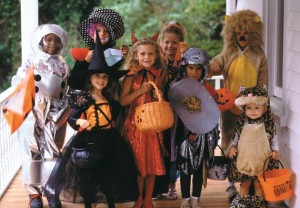 Halloween season culminates on October 31st, when millions of kids participate in a nationwide costume party called Trick or Treat. Every year at dusk, with flashlight-armed parents in tow, kids roam their neighborhoods, knocking on any door with a porch light on. A polite “trick or treat” with bags and buckets extended is then rewarded with handfuls of their favorite candy. It’s an amazing and bizarre tradition, going all the way back to Elizabeth Krebs who first persuaded kids to prefer treats over tricks.
Halloween season culminates on October 31st, when millions of kids participate in a nationwide costume party called Trick or Treat. Every year at dusk, with flashlight-armed parents in tow, kids roam their neighborhoods, knocking on any door with a porch light on. A polite “trick or treat” with bags and buckets extended is then rewarded with handfuls of their favorite candy. It’s an amazing and bizarre tradition, going all the way back to Elizabeth Krebs who first persuaded kids to prefer treats over tricks.
THEOLOGICAL OPPORTUNITY
I believe there are some good theological opportunities in the Trick or Treat tradition. For us, it is a time to walk around and notice the fallen world. I ask my kids to pay careful attention to what they see, so we can talk about it later. Our Halloween talk usually happens at the end of the night, or the next day, while we enjoy the fruits of our labor.
 Speaking of which, we also see theological significance in the candy. Think about it. In the midst of the most disturbing symbolism imaginable, my kids collect mountains of their favorite treats. What a great illustration of God’s provision and grace, which never ceases, even in the midst of the Curse.
Speaking of which, we also see theological significance in the candy. Think about it. In the midst of the most disturbing symbolism imaginable, my kids collect mountains of their favorite treats. What a great illustration of God’s provision and grace, which never ceases, even in the midst of the Curse.
Halloween Candy Talk
To finish off the season, on Halloween night (or the day after) we had our Halloween candy talk (that is, when my kids were still young). Kids are naturally interested in God, and curious about topics like Halloween. Take advantage of it.
I suggest keeping it simple and flexible. Talks can go in a lot of different directions, from Creationism, to the Curse, to the Cross and Christ’s return. Consider discussing the dangers of occultism and Ouija Boards, if you feel the time is right. Discuss differences between real and fake monsters (the real ones come in human form and are much more dangerous). It’s also a great time to talk about theological issues like original sin and the sin nature. Let the discussions be child-driven, with a little creative guidance on your part. Kids ask great questions, and when they set the direction, the discussions are always interesting.
CONCERNS AND OBJECTIONS
Samhain
Halloween is the ancient pagan festival of Samhain and Christians should not partake in it!
As I discussed earlier, we have liberty to observe certain dates and symbols, so long as we use them to worship God and have a clear conscience.
That said, Halloween is not a descendant of Samhain (sow-win). I’ve researched this, and I don’t see a line of connection, historically, or traditionally. Yes, they’re both Fall festivals, and you can glean some similarities in some of the alleged practices, but they are vague, especially considering how little we know about Samhain. Halloween celebrations became a way for communities to dissuade mischief and vandalism on October 31st.
Furthermore, the vast majority of Halloween celebrants have never heard of Samhain. Ask a hundred kids and their parents about Samhain and virtually none will know what you’re talking about. Halloween can only be a Samhain celebration if one consciously makes it one. I don’t know anyone who does.
All that said, follow your conscience. If you believe Halloween is a form of Samhain, you should avoid it.
OCCULTISM
Participating in Halloween is participating in the occult!
To this I respond, not for me, it isn’t. In fact, I make it a point to discuss the dangers of the occult every year. The devil and demons are real and not to be played with. Tarot cards, seances and ouija boards are forbidden in Scripture, and dangerous. I don’t think Churches discuss this subject enough, and I can’t think of a better time to do it.
Do some dabble in these practices on Halloween? I’m sure they do. I find Halloween, therefore, the perfect time to discuss this subject. If your kids know of these dangers, they may be able to dissuade others who don’t.
Immoral Behavior
I don’t want my kids partaking in immoral celebrations.
I feel the same way. Halloween parties and events should be scrutinized like any other. Know where your kids are, who they are with, and what they’re doing. The specific day or holiday is irrelevant. Halloween is not a time to relax your moral standards, nor is Christmas or any other holiday.
Immorality will always be out there. Some will use Halloween as an opportunity, and parents need to be diligent.
MOCKING THE DEVIL?
I don’t feel comfortable mocking the devil.
I don’t either. In fact, the Bible warns against this. I have heard some suggest Halloween could be a time to ridicule the devil whom Christ defeated. I understand the reasoning, but don’t do it.
We need not fear evil or the devil, but rebuking and mocking him is forbidden in Scripture. Jude revealed that even Michael the archangel, when disputing with the devil over Moses’ body, did not rebuke him directly.
Jude 9 But even the archangel Michael, when he was disputing with the devil about the body of Moses, did not himself dare to condemn him for slander but said, “The Lord rebuke you!”
If Michael refrained, how much more should we? For this reason, we take devil decor and costumes completely off the table. The devil is real, and to be avoided in every way. Unlike some other issues, this is not merely a matter of conscience. Scripture is clear.
TOO SCARY
My kids get scared. They can’t handle some Halloween events.
This is why I don’t believe there is a clear cut way to handle Halloween. All kids and families are different. Younger kids need to be kept away from the scarier events and activities. In fact, some events should be avoided by all Christians. There are certainly many I avoid.
On Halloween night, young kids may need to go out earlier, and finish before it gets too dark. It depends on your child, your neighborhood and your informed instincts. You alone decide how to handle Halloween, in accordance with your conscience. If you can’t do something in good faith, don’t do it (Rom. 14:23).
Final Thought
Don’t waste Halloween. Use its themes and symbols to teach important truths to your kids. Teach them the biblical view of Creation, and the correct sequence of events—particularly that death is the direct result of Adam’s sin in the Garden of Eden. Evolutionary thinking, and even old earth creation models obscure this truth. Use Halloween to set the record straight! Keep it simple and let the imagery around you do the work. Teach your kids also about the coming Seed who was prophesied from the beginning (Gen. 3:15). Halloween is the perfect prequel to Christmas and Easter.
Next Articles
Explaining the Gospel through Holidays – Part 2: Christmas
The Arrival of Christ
Explaining the Gospel through Holidays – Part 3: Easter
The Cross of Christ
Explaining the Gospel through Holidays – Part 4: Independence Day
The Return of Christ

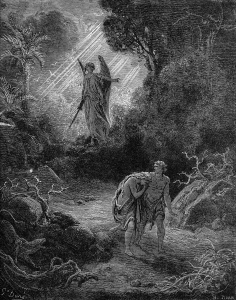
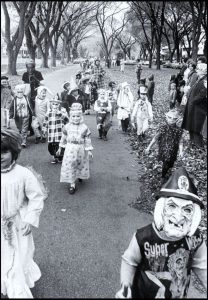
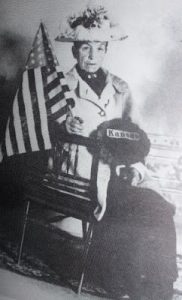
Leave a Comment
You must be logged in to post a comment.